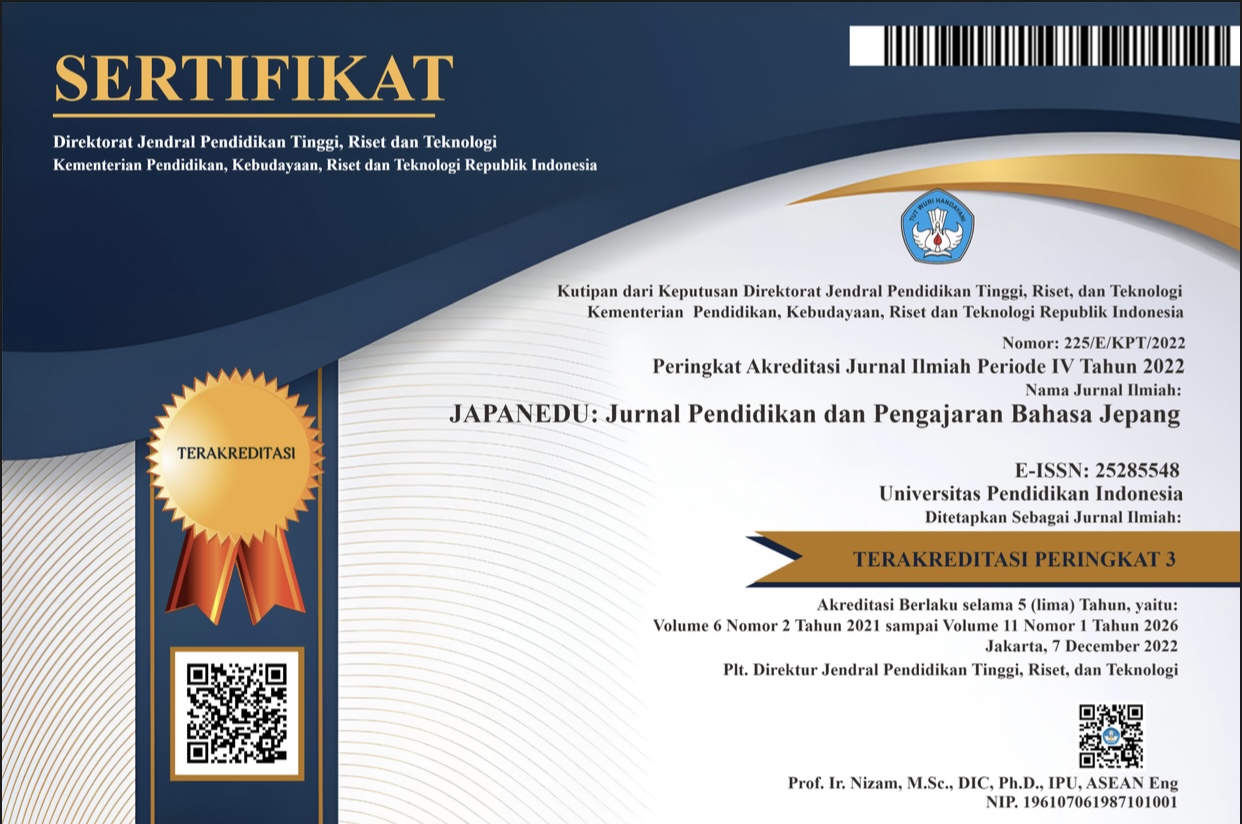Japanese and Indonesian Prohibitive Expressions on Prohibition Signs at Train Stations: A Linguistic Landscape Study
Abstract
Keywords
Full Text:
PDFReferences
Afifah, M. (2020). Nihongo to Indoneshia-go no kinshi hyōgen no hikaku: Kinshi sain ni okeru `hairyo’ o megutte [Comparison of prohibitive expressions in Japanese and Indonesian: Concerning “Consideration” in prohibited signs]. Nihon goyōron gakkai dai 22 kaitaikai happyō ronbun-shū, 207-210.
Brown, P. & Levinson, S. C. (1987). Politeness: Some Universals in Language Usage. Cambridge: Cambridge University Press
Ide, S. (2006). Wakimae Goyōron [Understand Pragmatics]. Tokyo: Taishūkanshoten.
Ito, E. (2004). Taikei to shite no keigo o motanai gengo wa teinei-sa o dō hyōgen suru no ka? - Kotowari bamen ni okeru Jawa-go to Indoneshia-go [How does a language that does not have a system of honorifics express politeness? Javanese and Indonesian in Refusal Scenes]. Kotoba to Ningen, 5,11-20.
Japanese Agency for Cultural Affairs. (2007). Keigo no shishin [Honorific Guidelines]. Tokyo: Bunkachō bunka shingikai kokugo bunka-kai. Retrieved from https://www.bunka.go.jp/seisaku/bunkashingikai/sokai/sokai_6/pdf/keigo_tousin.pdf
Kishie, S. (2012) Kanban hyōji-mono ni mi rareru kinshi hyōgen no gengo keikan [Language Landscape of Prohibitive expressions Seen on Signboards and Displays]. In J. Uchiyama, S. Nakai, & D. Long (Eds.), Sekai no gengo keikan Nihon no gengo keikan ― keshiki no naka no kotoba [Linguistic landscapes of the world Japanese linguistic landscapes - words in landscapes]. Tokyo: Katsura shobō.
Kim, S. (2011) Nihongo to kankokugo no gengokeikan ni okeru kinshihyougen kotoba [Forbidden Expressions in Japanese and Korean Linguistic Landscapes]. Meikai Nihongo, 66、71-78
Kurabayashi, H. (2020) Nihon no kōkyō sain no sutairu [Japanese public sign style]. Buntai-ron Kenkyū, 66、71-78.
Lu, X. (2014). Nihongo no keigo shiyō to poraitonesu [Japanese honorific use and politeness]. Bunmei 21, 33, 93-102.
Matsumoto, Y. (1988) Reexamination of the Universality of face: Politeness phenomena in Japanese. Journals of Pragmatics, 12, 403-426.
Nakazaki, A. (1999) “Kinshi/ fukyoka” teiji hyōshiki hyōgen no eigo taishō bunseki [Contrastive English-language analysis of “prohibited/not permitted” indications and sign expressions]. Hokurikudaigaku kiyō, 23, 179-189.
Safriyah, A. (2015) Tindak Tutur Imbauan dan Larangan pada Wacana Persuasi di Tempat-Tempat Kos Daerah Kampus [Speech acts of appeals and prohibitions on persuasive discourse in boarding houses on campus] (Thesis). Universitas Muhammadiah Surakarta.
Sasanti, Y. N.(2013)Tindak Tutur “Melarang” dalam Bahasa Indonesia [Speech act “forbidding in Indonesian Language]. Jurnal Penelitian, 16, 2, 196-206.
Schulze, I. (2019). Bilder – Schilder - Sprache: Empirische Studien zur Text-Bild-Semiotik im öffentlichen Raum [Images - Signs - Language: Empirical Studies On Text-Image Semiotics In Public Space]. Germany: Narr Dr. Gunter.
Takiura, M. & Ohashi, R. (2015). Nihongo to komyunikēshon [Japanese Language and Communication]. Tokyo: Hōsōdaigaku kyōiku shinkō-kai.
BPS- Statistic Indonesia (2021, January 21) Hasil Sensus Penduduk 2020 [Result of Census 2020] (accessed 2022, October 29) https://www.bps.go.id/pressrelease/2021/01/21/1854/hasil-sensus-penduduk-2020.html
Statistics Bureau of Japan (2022, April 15) Jinkou Suikei 2021-nen (reiwa 3-nen)10-gatsu tsuitachi [Summary of Population Estimates (October 1, 2021) Results] (accessed 2022, October 29) https://www.stat.go.jp/data/jinsui/2021np/index.html
DOI: https://doi.org/10.17509/japanedu.v7i2.51851
Refbacks
- There are currently no refbacks.
Copyright (c) 2022 JAPANEDU: Jurnal Pendidikan dan Pengajaran Bahasa Jepang

This work is licensed under a Creative Commons Attribution-ShareAlike 4.0 International License.
 Published by:
Published by: Department of Japanese Language Education, Faculty of Language and Literature Education
Universitas Pendidikan Indonesia
 Online ISSN: Online ISSN:2528-5548 |

JAPANEDU: Jurnal Pendidikan dan Pengajaran Bahasa Jepang (e-ISSN:2528-5548) lisenced under a Creative Commons Attribution-ShareAlike 4.0 Internasional (CC BY-SA 4.0)


